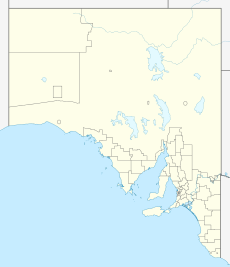Kelvin Powrie Conservation Park facts for kids
Quick facts for kids Kelvin Powrie Conservation ParkCoombe and Keith, South Australia |
|
|---|---|
|
IUCN Category III (Natural Monument)
|
|
| Nearest town or city | Keith. |
| Established | 4 March 1971 |
| Area | 17 hectares (42 acres) |
| Managing authorities | Department for Environment and Water |
| See also | Protected areas of South Australia |
Kelvin Powrie Conservation Park is a special place in South Australia that helps protect nature. It's located in the south-east part of the state, near the towns of Coombe and Keith. The park is about 8 kilometers north-west of Keith's town center.
Discovering Kelvin Powrie Conservation Park
Where is the Park?
This conservation park is located between two important routes. The Dukes Highway is on its south-west side, and the Melbourne–Adelaide railway is on its north-eastern side. It sits right on the border between the areas known as Coombe and Keith. The park covers land in specific administrative areas called the hundreds of Archibald and Stirling.
How the Park Started
The park was first created on March 4, 1971. Back then, it was called the Kelvin Powrie National Parks Reserve. It was set up under a law called the National Parks Act 1966.
A little over a year later, on April 27, 1972, its name changed. It became Kelvin Powrie Conservation Park when a new law, the National Parks and Wildlife Act 1972, was put into place.
Who Was Kelvin Powrie?
The park is named after a scientist named James Kelvin Powrie. He was a research scientist who made an important discovery. He found that the soil in this area was missing a tiny but crucial element. This area was once known as the Ninety Mile Desert. His work helped people understand how to make the land better for farming.
As of July 2016, the conservation park covers an area of 17 hectares. That's about the size of 17 international rugby fields!
What the Park Looks Like
In 1992, experts described the park's landscape. It has a flat limestone plain with small, gently rising sand dunes. These dunes run generally from east to west through the park. The soil is mostly deep, sandy, and light-colored.
Plants You Might See
The park is home to different types of native plants:
- In the south, you can find a low, open woodland with pink gum trees. There are also many heath plants growing underneath them.
- In the north, there's a largely treeless heath area. This is connected to low, sandy rises.
- A band of coastal white mallee trees grows through the center of the park. They follow the top of the dune system from the north-west to the south-east.
Visiting the Park
If you visit Kelvin Powrie Conservation Park, you'll find some helpful facilities. There's a parking area and a picnic spot. These are mainly for people who are taking a short break from traveling along the Dukes Highway.
There's also a walking track you can follow. It starts from the parking area and goes north-west. The track leads to the top of a dune. From there, you can get a great view of the heath plants in the northern part of the park.
Protecting the Park
Kelvin Powrie Conservation Park is classified as an IUCN Category III protected area. This means it's recognized internationally for protecting a specific natural feature.
In 1980, the park was also listed on something called the Register of the National Estate. This register used to keep track of important natural and cultural places in Australia, but it no longer exists.


